
The Royal Regiment of Artillery, commonly referred to as the Royal Artillery (RA) and colloquially known as "The Gunners", is one of two regiments that make up the artillery arm of the British Army. The Royal Regiment of Artillery comprises thirteen Regular Army regiments, the King's Troop Royal Horse Artillery and five Army Reserve regiments.

Woolwich is a town in southeast London, England, within the Royal Borough of Greenwich.

John Nash was one of the foremost British architects of the Georgian and Regency eras, during which he was responsible for the design, in the neoclassical and picturesque styles, of many important areas of London. His designs were financed by the Prince Regent and by the era's most successful property developer, James Burton. Nash also collaborated extensively with Burton's son, Decimus Burton.
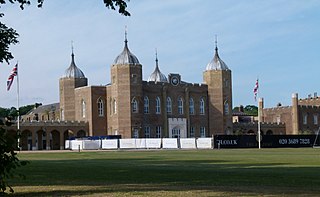
The Royal Military Academy (RMA) at Woolwich, in south-east London, was a British Army military academy for the training of commissioned officers of the Royal Artillery and Royal Engineers. It later also trained officers of the Royal Corps of Signals and other technical corps. RMA Woolwich was commonly known as "The Shop" because its first building was a converted workshop of the Woolwich Arsenal.

The Royal Arsenal, Woolwich is an establishment on the south bank of the River Thames in Woolwich in south-east London, England, that was used for the manufacture of armaments and ammunition, proofing, and explosives research for the British armed forces. It was originally known as the Woolwich Warren, having begun on land previously used as a domestic warren in the grounds of a mid-16th century Tudor house, Tower Place. Much of the initial history of the site is linked with that of the Office of Ordnance, which purchased the Warren in the late 17th century in order to expand an earlier base at Gun Wharf in Woolwich Dockyard.

Woolwich Common is a common in Woolwich in southeast London, England. It is partly used as military land and partly as an urban park. Woolwich Common is a conservation area. It is part of the South East London Green Chain. It is also the name of a street on the east side of the common, as well as an electoral ward of the Royal Borough of Greenwich. The population of the ward at the 2011 Census was 17,499.

Carlton House Terrace is a street in the St James's district of the City of Westminster in London. Its principal architectural feature is a pair of terraces, the Western and Eastern terraces, of white stucco-faced houses on the south side of the street, which overlook The Mall and St. James's Park. These terraces were built on Crown land between 1827 and 1832 to overall designs by John Nash, but with detailed input by other architects including Decimus Burton. Construction was overseen by James Pennethorne. Both terrace blocks are Grade I listed buildings. A separate but linked cul de sac at the terrrace's western end is named Carlton Gardens.
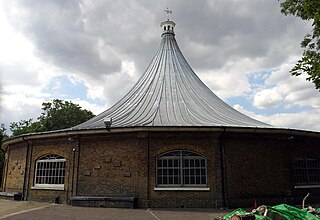
The Royal Artillery Museum, which was one of the world's oldest military museums, was first opened to the public in Woolwich in southeast London in 1820. It told the story of the development of artillery through the ages by way of a collection of artillery pieces from across the centuries.

Woolwich Garrison is a garrison or station of the British Army. Geographically it is in Woolwich, in the Royal Borough of Greenwich. In terms of command, it is within the Army's London District.

The Royal School of Artillery (RSA) is the principal training establishment for artillery warfare in the British Army. Established in 1915, it is located at Larkhill, Wiltshire, on the south edge of Salisbury Plain in the United Kingdom. The School is the primary training facility for Royal Artillery recruits, and is also home to the Gunnery Training Team.
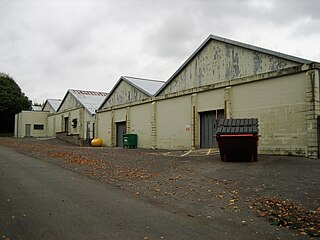
Larkhill is a garrison town in the civil parish of Durrington, Wiltshire, England. It lies about 1+3⁄4 miles (2.8 km) west of the centre of Durrington village and 1+1⁄2 mi (2.4 km) north of the prehistoric monument of Stonehenge. It is about 10 mi (16 km) north of Salisbury.
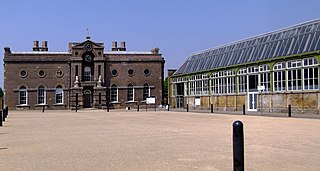
Greenwich Heritage Centre was a museum and local history resource centre in Woolwich, south-east London, England. It was established in 2003 by the London Borough of Greenwich and was run from 2014 by the Royal Greenwich Heritage Trust until the centre's closure in July 2018. The museum was based in a historic building in Artillery Square, in the Royal Arsenal complex, which was established in the 17th century as a repository and manufactory of heavy guns, ammunition and other military ware.

Barrack Field is located on the grounds of the Royal Artillery Barracks in Woolwich, southeast London. It was once part of Woolwich Common, then used as a venue for cricket matches in the 18th century and as the home of Woolwich Cricket Club at that time. Later it became the home of the Royal Artillery Cricket Club. It is now used as a generic sports field, mainly for football.
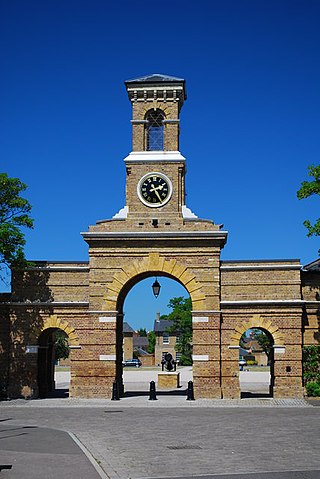
MoD Shoeburyness is a military installation at Pig's Bay near Shoeburyness in Essex.

St George's Garrison Church is a ruined church in Woolwich in the Royal Borough of Greenwich, South East London. It was built in 1862-63 as a Church of England place of worship for the Woolwich Royal Artillery garrison. The church was hit by a V-1 flying bomb in 1944 and largely destroyed by fire. The restored ruin with its canopied roof, its blue, red and yellow brick walls, its mosaics and a memorial garden is open to the public on Sundays.

The Garrison Church of St Alban the Martyr is a Church of England church in Larkhill, Wiltshire, England.

Royal Artillery Barracks, Woolwich, is a barracks of the British Army which forms part of Woolwich Garrison. The Royal Regiment of Artillery had its headquarters here from 1776 until 2007, when it was moved to Larkhill Garrison.

Woolwich Works, also known as Woolwich Creative District, is a multi-disciplinary cultural venue on the south bank of the River Thames in Woolwich in southeast London, that opened in September 2021.
Repository Woods is a 7 acres (2.8 ha) deciduous woodland area to the west of the British Army's Woolwich Garrison in the Royal Borough of Greenwich in southeast London. Initially created for pleasure use in the early 19th century, it was later used for military training, and is designated at Grade II as the UK's earliest known purpose-built military training landscape. Its features include training and practice earthworks, a stream and man-made lake and terraces. A Rotunda, designed by John Nash in 1814, is nearby.





















